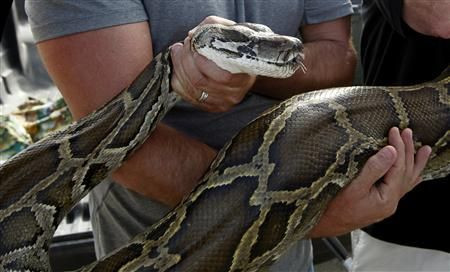Lifeless farmer found inside a python’s body

A missing farmer was found inside the body of a seven-metre long python in Indonesia's West Sulawesi province. Residents in Karossa district cut the snake open and found Akbar Salubiro, who was supposed to harvest palm oil in a nearby plantation, lifeless.
The man’s dead body was fully clothed, and the boots he was wearing were clearly visible in the python’s stomach. "People had heard cries from the palm grove the night before Akbar was found in the snake's stomach," village secretary Salubiro Junaidi told Straits Times.
Salubiro went missing on Saturday, March 25, after he went to a remote village on the island of west Sulawesi. “Initially Akbar set out from his home to go to harvest palm. After not returning to his home, people looked for him,” Salubiro’s neighbour said.
Villagers discovered the snake, which was classified as a reticulated python, a day later and noticed the sizable bulge in its stomach. It was reportedly hanging in Salubiro’s back garden and caused fear that it swallowed the missing farmer.
The locals decided to cut the snake’s body using an 18-inch long hunting knife. Salubiro’s lifeless body was found. The corpse was removed from the snake’s skin.
Munu, the farmer’s wife, reportedly learned about the death of her husband through images and video that surfaced in the media. She was away from home when the incident happened.
Reticulated pythons, which are among the world’s largest snake species, are found in Southeast Asia and some are introduced in southern Florida, a direct result of the effects of pet importation. The breed kills its prey by suffocating it before swallowing it whole, and was said to be responsible for a number of human deaths. In 2002, Telegraph reported that a 20ft-long African rock python had swallowed a 10-year-old boy near Durban, which marked the first "man-eating" incident for its species.
A snake's jaw is put together with tendons, muscles, and ligaments, making it flexible. "One of the enduring myths about snake feeding mechanisms is the idea that the jaws detach," Live Science quotes Patrick T. Gregory, a biology professor at the University of Victoria. The animal’s stomach has very strong acids in it that slowly digest its food, which means when it has swallowed a large item of prey, it must rest for several days.
Per animaldiversity.org, pythons camouflage to hide before they attack their prey. The same behaviour is noticeable in wetlands where reticulated pythons can conceal themselves.





















